Water is unarguably the earth’s most important resource. The presence of water is the only reason for the existence of life forms on earth is possible. A lot of evolution theories say that life started on earth because of water. When scientists look at other planets to judge whether life there is possible or not, they consider the presence of water first and foremost. Water that is used for drinking is known as potable water and it is sad to see that this potable water and its sources are dwindling day by day. The quality of drinkable water is not in the best place right now and that is the exact reason why water purifying is the need of the hour.
Table of Contents
RO Vs UV Vs UF
Reverse Osmosis (RO)
In a reverse osmosis system, tap water is pushed through a semipermeable membrane to remove impurities present in the water. Due to this process, dissolved inorganic solids such as salts are removed from the water. In addition to the RO filter (semipermeable membrane), an RO system also has other filters such as sediment filter or carbon filter. Most RO units incorporate a 4 stage process for optimal water quality. RO process has been in use since 1977 by municipalities.
Pros
- Reverse Osmosis is a great way of purifying and treating hard water.
- RO purifiers remove lead, mercury, fluoride, arsenic, and chlorine.
- It is efficient at removing commonly found “Cryptosporidium” which is found in lakes, rivers, and public supply water.
- Separation is performed without phase change so energy requirements are rather low
- Their design is modular so expansion is an easy option.
- Again, due to this modular design, maintenance is easy and can be performed without shutting down the entire plant.
- RO systems are compact and space requirements are reasonable.
- RO equipment includes – pumps, motors, valves, pressure gauges, etc., therefore unskilled laborers can easily understand it’s mechanics since the equipment is quite standardized.
- Most RO systems are fully automated so they usually require little to no labor.
Cons
- If RO feed-streams contain incompatible compounds, they must be immediately removed in pretreatment and/or another compatible device must be considered. Thus RO feed-streams must be compatible with the membrane.
- All RO membranes are prone to be fouled, thus RO process cannot take place without pretreatment.
- RO also removes essential minerals such as magnesium, calcium, iron, and sodium which are important for humans and may cause a deficiency if not taken in a required amount.
- It is unable to kill water-borne disease-causing bacteria and viruses. Therefore micro-organisms can easily pass through the RO membrane.
- Water becomes tasteless as essential minerals are removed.
- RO purifiers are much more costly compared to UV purifiers and often use higher electricity.
- Water purification takes a lot of time.
- RO membranes are susceptible to breaking as chlorine can, over time, make small pores in the membrane which can lead to more impurities passing through.
Ultraviolet Purification (UV)
UV water purification is considered the best water purification method by many. Ultraviolet rays penetrate harmful pathogens and decentralize disease-causing viruses and bacteria by attacking their genetic core (DNA).
This contributes to reducing their ability to reproduce. UV systems destroy 99.99% of harmful micro-organisms without either adding chemicals or changing the water’s taste or smell.
Pros
- This whole process is chemical-free. Thus, zero chlorine usage and there are no by-products.
- There is no odor or taste change at the end of the purification.
- There is no need for constant maintenance as it is a set and forget type of system. The YV Bulb has to be changed annually.
- Extremely effective.
- Uses as much energy as a 60W light bulb.
- Since there is an absence of chemicals, therefore it doesn’t damage any pipes.
Cons
- UV systems require electricity to work, therefore if you’re living in an area with constant power outages, a UV system would be disadvantageous.
- Although UV water purifiers remove bacteria and viruses but fail to act on dissolved impurities such as rust, pesticide, fluoride, arsenic, etc. it is also not effective on muddy water.
- There is no external storage tank option, therefore the consumer must have to fill the water in bottles externally.
- Ultraviolet light is invisible, therefore it is impossible to know whether the appliance is working or not. So if the purifier stops working one day, the consumer won’t be notified of the same and may end up consuming impure water.
- Water needs pre-filtration before it undergoes UV purification.
- It only works on water that has a TDS (Total Dissolved Salts) of up to 200 ppm (parts per million). The UV purification won’t work on water having a TDS limit greater than that.
Ultrafiltration Purification (UF)
Ultrafiltration method, unlike the RO and UV process, is a one membrane separation process that works as a barrier that separates harmful micro-organisms such as bacteria, viruses, etc. from clean water.
This system forces water through a 0.2-micron membrane which is slightly larger than an RO membrane. As a result, suspended particles that are too large to pass will stick outside on the membrane. As a result, only clean water and dissolved minerals can pass through, unlike the RO membrane which barricaded even the dissolved minerals.
Pros
- Works without electricity so there are no issues regarding power outages.
- Chemical usage is negligible maintaining the taste of water.
- It provides pure drinking water better than boiled water because it washes out all germs, dirt, and cysts.
- Removes a large number of suspended particles and can even muddy water effectively.
- The UF filter is extremely durable and does not crack.
- No annual maintenance needed. It has a longer shelf life compared to other purifiers and can be cleaned by flushing blocked impurities on its own.
- It physically removes all the unneeded micro-organisms from the water. Compared to that, the UV water system only kills the bacteria and viruses but their dead bodies still remain in the water.
- Pocket-friendly and costs way lesser compared to RO and UV systems.
- RO water purifier wastes a lot of water but UF filtration retains every single drop of water, so the output water is the same as the amount of water you fill in.
- UF systems are simple and compact.
Cons
- UF cannot separate dissolved salts and therefore cannot be used to desalt water.
- Sometimes this process might end up in being unadvisable for drinking since it is unable to separate soluble substances from water which might end up causing harm to the consumer’s health.
Ultraviolet and Ultrafiltration methods are unable to eliminate Total Dissolved Solids whereas RO shines out in this department, it also eliminates dissolved salts and harmful heavy metals such as lead, arsenic, etc.
An ideal water purifier is the one which is a combination of RO+UV+UF for best quality of water but if you plan on buying one of the three mentioned purifiers, then go for an RO water purifier.
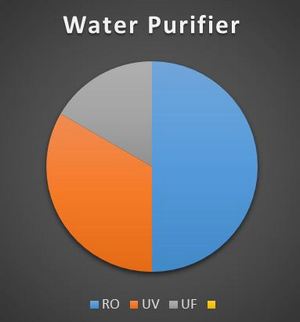
5 Best RO water purifiers available online
Kent Grand 8-Litre Mineral RO and UV/UF Water Purifier
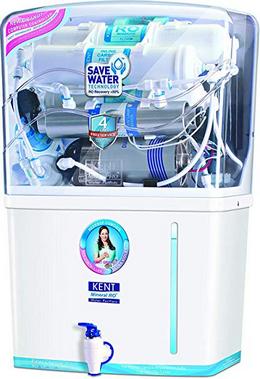
- 8-liter capacity
- Double purification
- Purify water from all inlet sources
Havells Max 8-liters RO UV Water Purifier
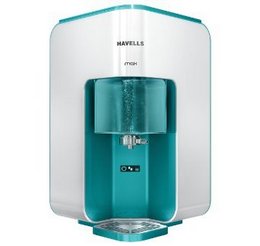
- 8-liter capacity
- Mineralizer function restores lost minerals
- Revitalizer restructures the water molecules
- High maintenance, especially in high TDS areas
- Buying yearly warranty is expensive
Eureka Forbes Aquasure Smart Plus 6-liters RO+UV+MTDS Water Purifier
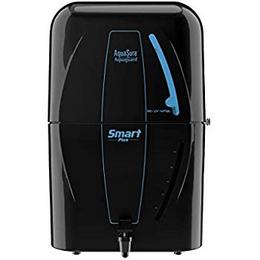
- 6-liter capacity. Tad bit small
- RO+UV purification technology
- Energy-saving mode available
- MTDS controller available
- Great design
- Wastes water like all RO purifiers
LG Puricare WW180EP RO+UV+Mineral Booster Water Purifier
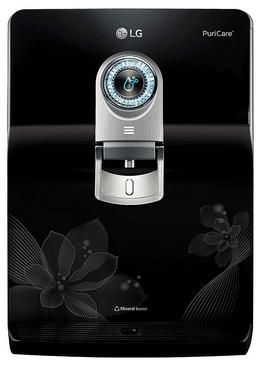
- 8-liter capacity
- Dual protection steel tank
- RO, UV and UF filtration
- Mineral Booster
- High level of sterilization
- Stainless steel tank prevents algae
- Expensive for a middle-class Indian family
- Wastes water like every other RO purifier
Kent Ace Mineral 7-litre 60 Watt RO+UV+UF Water Purifier
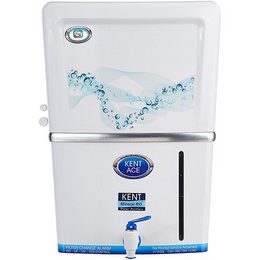
- RO+UV+UF purification technology
- 7-liter capacity
- High-quality plastic storage tank
- 1-year warranty
- 3-year no charge service promise
- Prompt after-sales service
5 Best UV Water Purifiers Available Online
Kent Maxx UV+UF Water Purifier
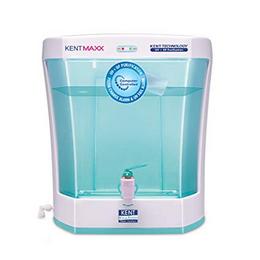
- Detachable transparent water tank, easy to clean
- Dual UV and UF purification
- Computerized controlled alarm system that alerts you to change the filters or UV lamp
- Inbuilt voltage stabilizer
Eureka Forbes Aquaguard Crystal Plus UV
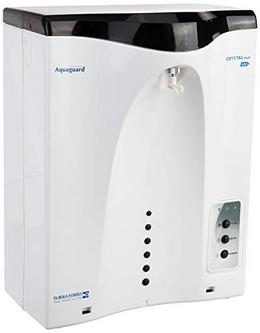
- Electronic monitoring system for detection of any malfunction in the UV lamp
- Biotron cartridge breaks down the water molecules for easy absorption
- Backflush removes stagnant water
- Inbuilt voltage stabilizer
Eureka Forbes Aquasure Aquaflo DX UV Water Purifier
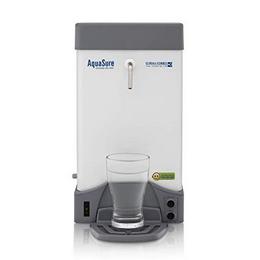
- Dual cartridge that can purify the water by eliminating suspended particles, organic compounds, odor from water
- Backflush removes stagnant water
Livpure Glitz 7L UV+UF Water Purifier
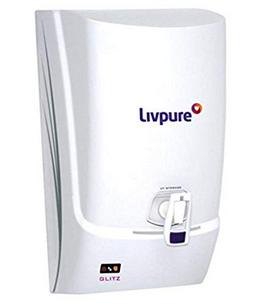
- Cartridge is easy to remove and fit and does not require the help of maintenance people.
- 4 stage UV+UF purification
- 60 liters per hour flow rate
- Electronic alert system
- Power saver technology
- Backflushing port to remove stagnant water
Pureit Classic UV+ Water Purifier
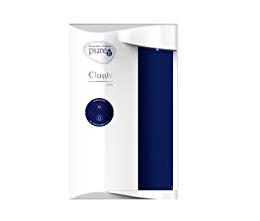
- Advanced alert system
- 5 stage purification
- High-intensity UV lamp
- Auto shut off technology
- Purification capacity of up to 2 liters per minute
Facts
Metro cities are the hubs of the Indian population and water consumption. Turns out, even the rich “1%” of the Indian populace has turned a blind eye to water and its rapid degradation.
India ranks third in the world for the extraction of groundwater after the United States of America and China. According to a report by Times of India, toxin discharge from industries and landfills and diffusion of contaminants such as pesticides and fertilizers over the years has resulted in high amounts of groundwater contamination with the level of nitrates exceeding permissible limits in more than 50% districts of India.
Apart from nitrate, the presence of arsenic, fluoride, iron and heavy metals have also reached worrying levels. These reports show that 7 out of Delhi’s 11 districts have excess fluorides, eight access nitrates, two excess arsenic and three excess lead in groundwater. There is excess nitrate in as many as 386 districts, fluoride in 335 districts, iron in 301 districts, salinity in 212, arsenic in 153 districts, lead in 93, and chromium in 30 districts and cadmium in 24 districts.
The Central Ground Water Board (CGWB) monitored about 15,00 wells located all over the country and the results showed that Punjab, Uttar Pradesh, Tamil Nadu, Haryana, West Bengal, and Telangana, all of these places contained all types of toxic elements, including heavy metals, in the groundwater of one or the other of their districts.
Conclusion
Drinking clean water and cooking food with said clean water can go a long way in maintaining one’s well-being. Overpopulation, growing industries, and environmental degradation are some causes that result in the scarcity of pure and clean drinking water.
Consumerism and industrialization have resulted in an unwanted by-product that is, plastic waste. Plastic waste thrown into water reservoirs reaches us is chock full of harmful toxins from plastic waste as well as other harmful contaminants.
Water, in general, contains a lot of minerals that are crucial for the human body but on the contrary, an excess of such minerals can turn out to be harmful.
To tackle such harmful hazards, one must really opt for water purifying systems.
